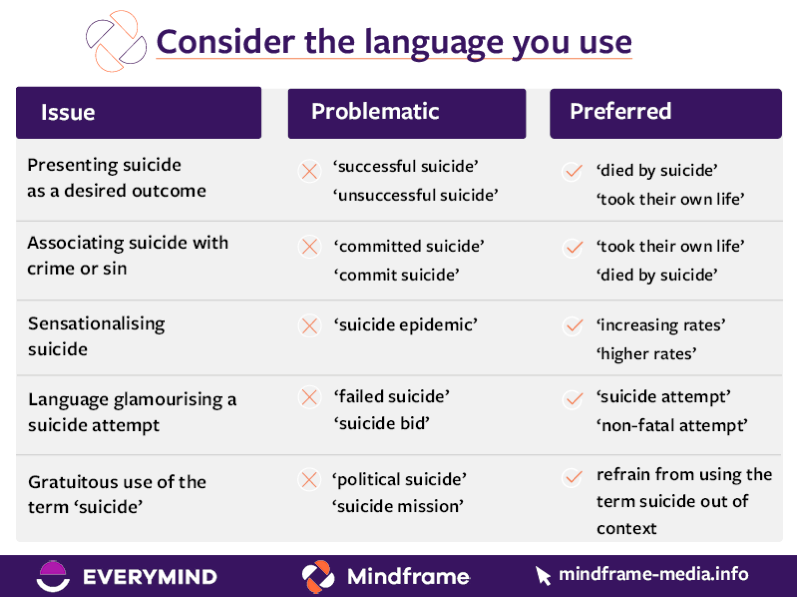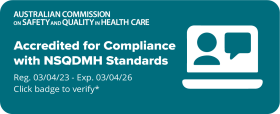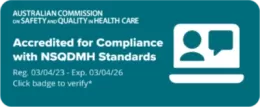Accessibility Tools
- Content scaling 100%
- Font size 100%
- Line height 100%
- Letter spacing 100%
The SANE Blog

Reporting on suicide incidents responsibly with Mindframe
We spoke with Jennifer from Mindframe, about how the media should be reporting on suicide to ensure it is safe, responsible and accurate.
What are the rules on reporting suicide?
We know through centuries of observation and hundreds of research articles, that discussing suicide can be harmful if too much information is given. This applies not just in news media, but in entertainment media as well.
As any good storyteller will tell you, be it on page, stage or the big screen – there is great skill in being able to paint a picture that invites a reader to imagine the finer details for themselves. Whether a story is to entertain or inform a reader, evidence demonstrates that discussing the loss of life by suicide can be harmful to people who are vulnerable.
Currently there are no set ‘rules’ around this but we do have well-supported guidance, which helps us understand how we can minimise harm and copy-cat behaviour. People who are experiencing thoughts of suicide are at a higher risk of being negatively impacted when there is graphic detail of how someone has taken their own life. Using stigma-free language and information that is void of explicit detail can still tell a story and is a safer way to present the topic of suicide.
What are the Mindframe guidelines?
Mindframe has developed national evidence- based guidelines to support safe reporting, portrayal and communication of suicide and mental ill-health. For more than two decades Mindframe has worked collaboratively to support Australian media and communications professionals. Media and communications professionals have an important role to play in shaping and reinforcing the social attitudes towards, perceptions and understanding of suicide and mental ill-health.
Mindframe has helped to motivate our storytellers and news media to safely produce articles, opinion pieces, novels, TV programs, movies, theatre and all other forms of media, to not only help protect people from over exposure of details, but debunk myths and steer people towards accessing help-seeking when needed.
What can you say? What can’t you say?
It’s not so much what you can or can’t say, but what the evidence says. Mindframe developed language guides to support anyone communicating about suicide to the public, to minimise risks on vulnerable audiences.

Preferred language helps reduce some of the stigma involved in communicating about suicide, with evidence showing that stigma can stop people from freely discussing their thoughts and feelings. Reducing stigmatising language can help encourage people to seek help by opening up opportunities to voice how they feel.
Evidence demonstrates vulnerable people are at a greater risk of copycat behaviour, when exposed to content around a death with exact known details around how and where someone died. These known details are termed as; method, means and location.
Discussion of unknown details is termed ‘speculation’ and is often based on assumptions around why someone died, which is also considered to increase risk.
Other notions such as memorialisation, romanticising, glorifying and even stigmatising people who have died by suicide are shown to have a negative impact on people who are thinking of ending their life.
Why can’t you say these things?
The evidence base tells us that detailing suicide deaths has been associated with increased rates of suicide and suicide attempts following this type of publication. The risk generally increases when the reporting focuses on an individual who has died, in particular when they are of celebrity and again, if the coverage is prominent and repeated. Still curious and want to learn more about communicating about suicide? Click Here.
Is there proof that reporting these things is bad?
Absolutely. Just recently, a study looked at the number of related deaths and attempts after problematic and repeated coverage of a celebrity suicide death made headlines around the world. Community members were exposed to very detailed reports of the death over weeks of public and online mourning.
This study looked at the observed number of deaths recorded using the same method, by people who were a similar age and gender as the celebrity, which paralleled the increase of problematic news reports of the death (versus number of deaths at the same time of the year, in previous years which used the same method).
Even more recently, a US study found a statistically significant increase in deaths in youths ages 10-17 in the month after the release of 13 Reasons Why (season one) and the two months following. This study, was initially run to evaluate the association between the releases of 13 Reasons Why and suicide rates in U.S. individuals aged 10 to 64, due to poor media coverage being known to increase risk to vulnerable individuals.
This is not a new phenomenon. In fact, it is centuries old and is termed ‘The Werther Effect’. Named after a pop-culture novel authored by Johann Wolfgang von Goethe in 1774, it is said to be one of the first and largest known cases of copy-cat suicide attributed to published media. This novel was popular throughout Europe and proved problematic amongst people who identified with the main character (age, gender, social class) and who had access to the same means of self-harm. The number of people directly impacted by this book is not known, but authorities were concerned enough to ban the book across all of Europe as there was a common link to the novel in a number of deaths. For more information about the evidence base and to access two recent critical reviews published by Mindframe click here.
What can I do if I see something reported I think is wrong?
For media news reports and articles, the best approach is to directly report the piece of media to SANE StigmaWatch for urgent follow-up. This reporting process will require information such as; where you saw the media coverage, name of journalist, headline, date/time etc. allowing for accurate follow up.
When reporting directly to SANE StigmaWatch, you will receive a follow-up email of actions taken from the team.
It you find illegal content such as the discussion of methods of self-harm online, you can report it directly to the eSafety.
For all other forms of media and entertainment media (books, theatre etc.), contact Mindframe and report problematic content for follow-up.
By accepting you will be accessing a service provided by a third-party external to https://www.sane.org/









